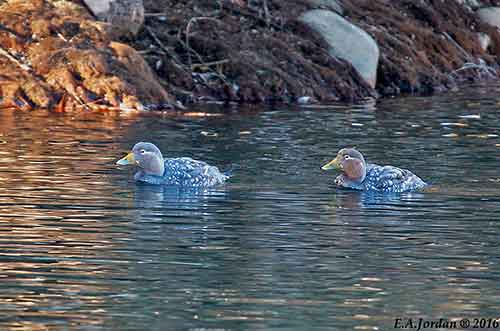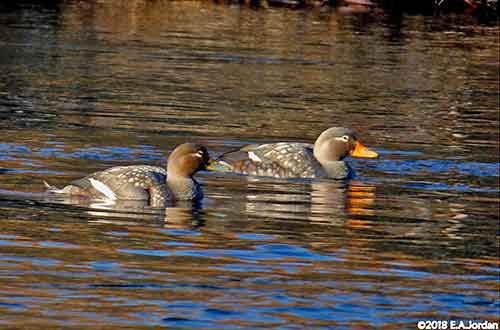
Fr: Brassemer de Patagonie
Ang: Flying Steamer Duck
All: Langflügel-Dampfschiffente
Esp: Quetro Volador
Ita: Anatra vaporiera volatrice
Nd: Vliegende Booteend
Sd: långvingad ångbåtsand
Photographers:
John Anderson
John Anderson Photo Galleries
Jean-Claude Billonneau
Photographe-témoin de la Beauté du Monde
Eduardo Andrés Jordan
MIS AVES – AVES DE ARGENTINA
Dubi Shapiro
Dubi Shapiro Photo Galleries
Philippe et Aline Wolfer
GALERIE
Text by Nicole Bouglouan
Sources:
HANDBOOK OF THE BIRDS OF THE WORLD vol 1 by Josep del Hoyo-Andrew Elliot-Jordi Sargatal - Lynx Edicions - ISBN: 8487334105
GUIDE DES CANARDS, DES OIES ET DES CYGNES – de Steve Madge - Delachaux et Niestlé - ISBN: 2603013769
Aves de los humedales chilenos: Guía de campo - De Pedro Pablo Rosso, Jaime Álvarez – Editeur: Ediciones UC, 2022 – ISBN: 9561430371, 9789561430372 – 240 pages
Notes on the behavior of the Flying Steamer Duck
Sistema de Información de Biodiversidad de la Administración de Parques Nacionales, Argentina
Arthur Grosset's Birds (Arthur Grosset)
Wikipedia, the free encyclopaedia
Wikipedia, la enciclopedia libre
Flying Steamer Duck
Tachyeres patachonicus
Anseriformes Order – Anatidae Family
INTRODUCTION:
The genus Tachyeres includes four almost similar species, large ducks that have partially lost the power of flight. However, they are able to fly occasionally, often low from water surface, never at great height.
They live close to coastal waters where they walk actively thanks to their powerful legs and feet.
The name of these ducks is closely related to their behaviour in the water. They perform rapid movements across the water, by using the wings in a circular padding motion to propel themselves.
The Flying Steamer Duck is very similar to the three other species which are flightless. It is smaller but with longer wings, especially longer projection of the primaries beyond the tertials, implying some flight possibilities. But he generally prefers to get around by walking.

The Flying Steamer Duck is found in the southern tip of South America, in Chile and Argentina, Tierra del Fuego and also in the Falkland Islands. It frequents both freshwater and marine environment. It feeds primarily on various aquatic invertebrates caught by diving into shallow water or by surface feeding.
The species is monogamous with long-term pair-bonds, and very territorial. The nest is a depression on the ground, often lined with down or plant material. It is well hidden among the vegetation and often built close to the water.
The Flying Steamer Duck is affected by hunting and egg collecting, and by disturbances during the breeding season by tourists. The population trend is decreasing but the species is not globally threatened at the moment.
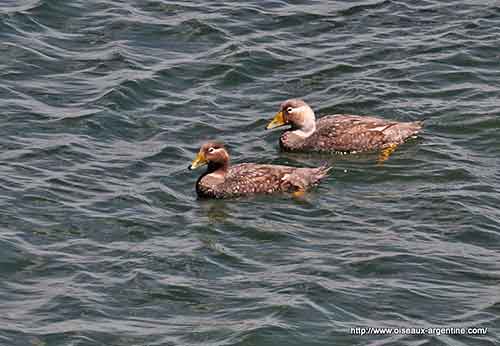
DESCRIPTION OF THE BIRD:
Biometrics:
Length: 66-71 cm
Weight: M: 2100-3600 g – F: 1665-3118 g
The Flying Steamer Duck male adult undergoes three moults showing three different plumages, especially variations of head and neck colour and pattern.
During most of the year, the male has greyish-brown head and neck, the crown is greyer and foreneck and throat are reddish. We can see a small, white line on the rear eye.
Between October and December (Southern Spring), the Flying Steamer Duck moults and shows different plumage with head and neck largely whitish, a pale grey wash on the cheeks, greyer lores and cinnamon throat.
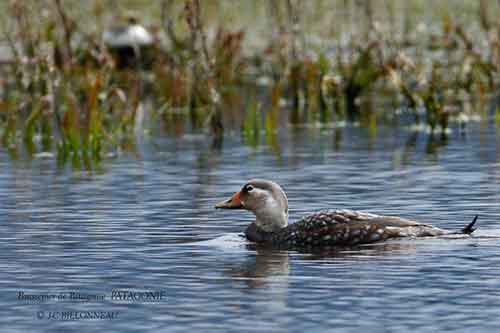
Between January and March (Southern Summer) the plumage changes again. Head and neck are entirely dark brown, the throat is cinnamon and the eyering is white.
Other changes can be seen with dark grey crown, rear of cheeks and neck sides paler brown than lores and face, or dark-purple-grey head and neck, dark cinnamon-red throat and short white line on the rear eye.
The body plumage resembles that of other Tachyeres ducks, with white secondaries and greater coverts forming a large, conspicuous wing patch, well visible in flight. Most of the body is greyish-brown with dark brown edges to feathers, involving conspicuous scaled pattern. Rump and uppertail-coverts are paler grey. The tail is dark grey with pointed rectrices.
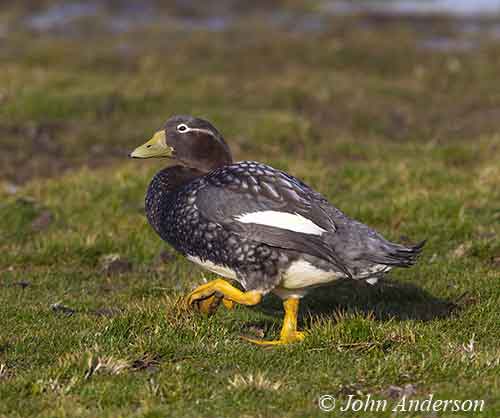
On the underparts, belly, flanks, vent and undertail-coverts are whitish. The underwing is white, except the dark greyish-black leading edge and the primary flight-feathers.
The streamer-ducks have a peculiar feature. They have well-developed orange “bumps” bare of feathers at the angle of the wing. They are modified spurs used in fights. The present species shows more pointed and slimmer spurs than the flightless ducks.
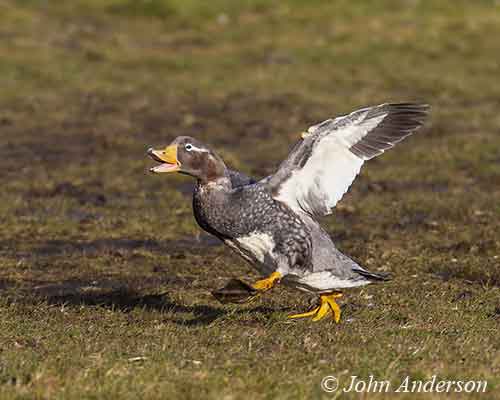
The adult male has orange or yellowish-orange bill, usually paler at tip. It becomes bluish-grey at tip during the moult of the wings. The nail is black.
The eyes are dark brown, surrounded by white eyering.
Legs and feet are strong, yellow-orange with dark webs. They are duller yellow during the moult of the flight-feathers (probably to avoid attracting attention because at this time the bird cannot fly away if threatened).
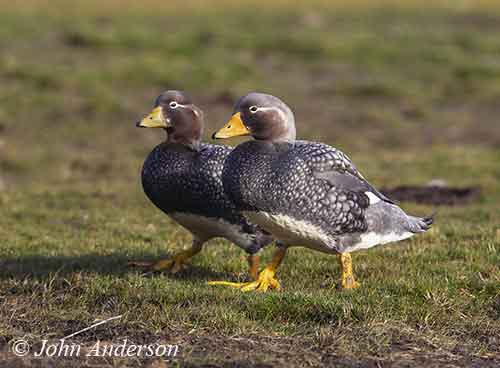
The adult female is slightly smaller than male. She has dark grey crown, dark brown lores and cheeks, the latter being paler on the rear. The neck sides are whitish and form a collar. The throat is dark rufous-cinnamon. We can see a curved white stripe on the rear eye.
In spring, this stripe becomes indistinct, the whitish collar is absent and the lores are more ginger.
In summer, the appearance of the female varies like in male. Head and neck are darker, the throat is dark rufous-cinnamon, the eyering is whitish and the white stripe is indistinct.
But the female may also show much paler rear neck and cheeks, and short but conspicuous eye stripe.
The bill is slate-blue with some yellow after the bill’s base. The nail is black.
The eyes are dark brown.
Legs and feet are yellow to orange-yellow with grey webs.
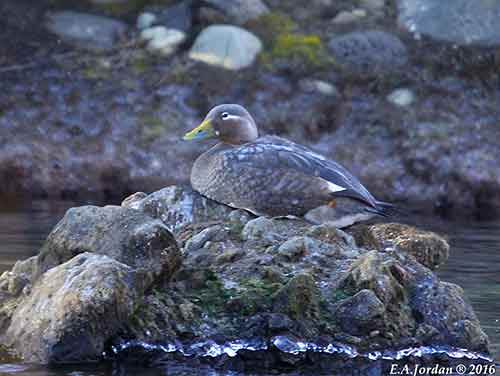
The juvenile has greyish plumage without wine-coloured tones. Head and neck are very dark brown, almost blackish-brown, whereas face and forehead are more ginger. We can see a pale stripe on the rear eye and a whitish eyering.
The bill is bluish-black with some orange wash at bill’s base. The nail is black.
The eyes are dark brown.
Legs and feet are dull brownish-yellow with darker webs.
It obtains the adult plumage at the end of the first year.
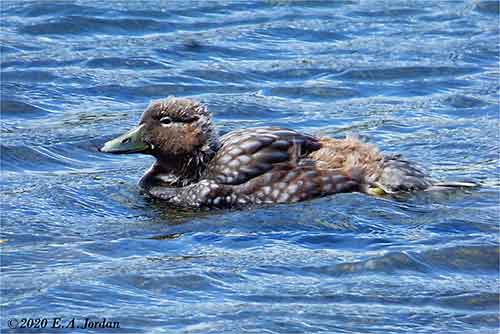
RANGE:
The Flying Steamer Duck is found on the coasts of S Chile (S from Ñuble), extreme S Argentina (S from Río Negro), Tierra del Fuego and Falkland Islands.
HABITAT:
The Flying Steamer Duck is observed in both freshwater and marine environments throughout the range.
During winter, it frequents the rocky coasts and forages both in freshwater ponds and estuaries.
It usually nests near lakes and streams, often far from the coasts. But it also may breed on small islets in well-concealed sites.
CALLS ANS SONGS: SOUNDS BY XENO-CANTO
The calls of the male Flying Steamer Duck consist of various high-pitched whistling notes, usually clear, loud and far-carrying. The species is known to repeat these notes rapidly, involving series of shrill notes.
The female gives shorter, deeper grunts, and croaks, cackles and growls. These sounds are often given in long series of rapidly repeated notes.
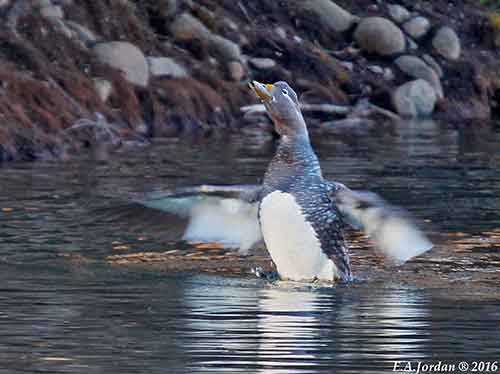
BEHAVIOUR IN THE WILD:
The Flying Steamer Duck feeds mainly on aquatic invertebrates such as molluscs (especially mussels - Mytilus) and crustaceans (especially Grapsidae crabs), and occasionally small fish. It may also consume snails, limpets and various bivalves, and smaller amount of shrimps, insects, annelids, fish and plants.
They usually feed in pairs. The food is obtained by diving underwater during about 30 seconds, also by surface-feeding, or by wading and probing at water’s edge. When foraging on inland waters, the species is mainly diurnal, whereas when feeding on coastal waters, it is dependent on the tides and often forages around the high tide.
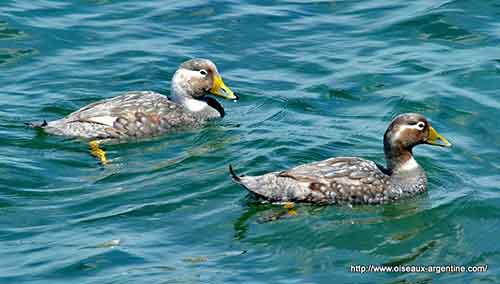
The Flying Steamer Duck is monogamous with long-term pair-bonds. The species is known for its highly aggressive behaviour which is probably part of the displays. The males may perform bloody battles with each other while defending the territory. The spurs are used during the fights, causing severe injuries or the death of a fighter.
The males have several types of displays, but the most elaborate is the “short-high-and-broad Posture” accompanied by rasping grunts.
The male stretches the neck upwards and slightly backwards, the head is held horizontal or the bill points slightly upwards. The tail is raised very high while spreading the rectrices. The wings are partly spread too.
The movements of both wings and tail emphasize the contrast between the dark rectrices and the white undertail-coverts, and enhance the conspicuous white wing patch.
This display can be seen during intra-specific disputes, while the males advance towards each other during the most intense territorial hostilities.
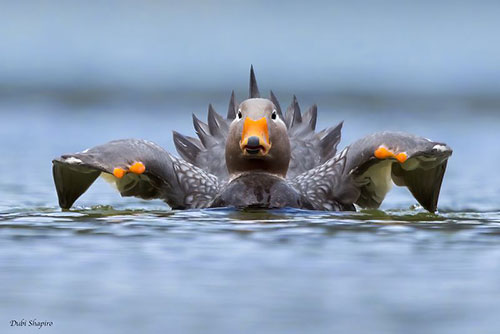
The Flying Steamer Duck nests on the ground on small islets. The nest-site is well concealed among the vegetation.
The copulation occurs on the water, following some bill-dipping first, and then, head and neck dipping by both adults. They perform fairly hostile Head-flagging and Grunting after the copulation.
The Flying Steamer Duck is mainly sedentary and only performs short movements along the coasts after the breeding season.
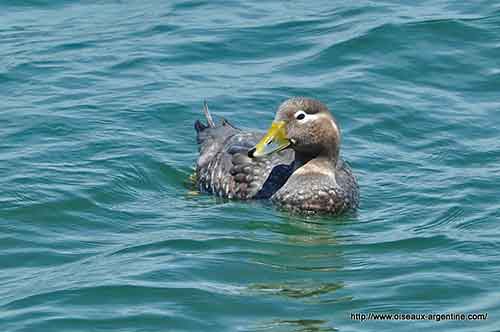
It is the only flying species of the genus Tachyeres. It has longer projection of primaries beyond the tertials, and it is smaller than the flightless species.
However, the Flying Steamer Duck has serious difficulties in taking off and needs to run over short distance. But once it takes off, it flies fast and strongly. But it often prefers to escape by running on the ground to hide, or by swimming or diving into nearby waters. But the largest, heaviest individuals cannot fly at all.
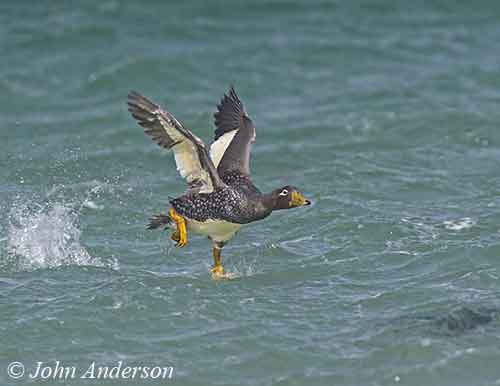
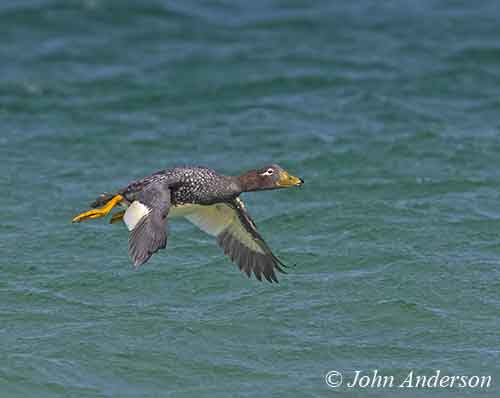
REPRODUCTION OF THIS SPECIES:
The breeding season starts in October/November (probably earlier on Falkland Islands), and continues until January.
The Flying Steamer Duck nests in single pairs. It is very territorial and aggressive.
The nest is on the ground, a shallow depression with a thick lining of down. The structure is made of small sticks and grass. The nest-site is concealed among woody vegetation or dense grass, on small islets. It can be close to the water, within a few metres, but also up to 400 metres away.
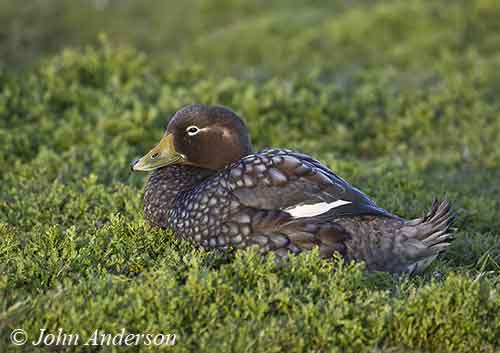
The female lays 7 (5-9) white/buff eggs, and incubates alone during 30-40 days, while the male defends the nest-site and the territory, but it may take part in nesting duties except incubation.
At hatching, the chicks have pale brownish down above and on the breast, and whitish below. They have a broad, white stripe through the eye and behind the cheeks. The bill is black.
They probably fledge about 12 weeks after hatching.
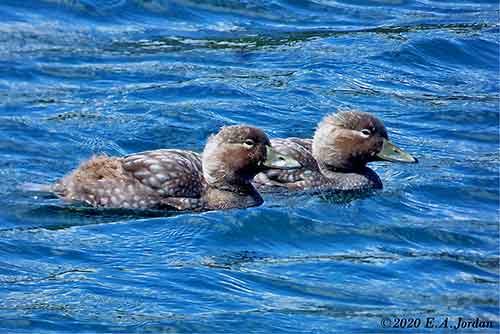
PROTECTION / THREATS / STATUS:
The Flying Steamer Duck can be affected by hunting and egg-collecting throughout the mainland range, but it is not thought to be driving significant decline. Some populations can also be disturbed by tourists during the breeding season.
The species is present in several protected areas.
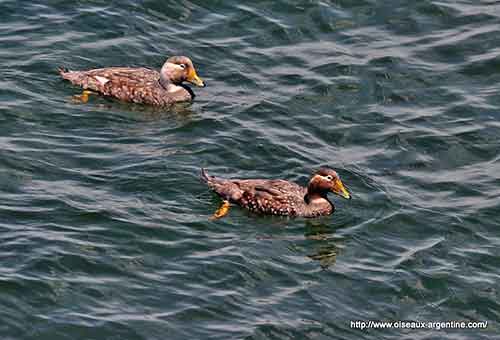
The size of the global population is estimated to number 11,000/26,000 individuals, equating to 7,300/18,000 mature individuals. The population trend is decreasing but more information is needed.
The Flying Steamer Duck is currently evaluated as Least Concern.
